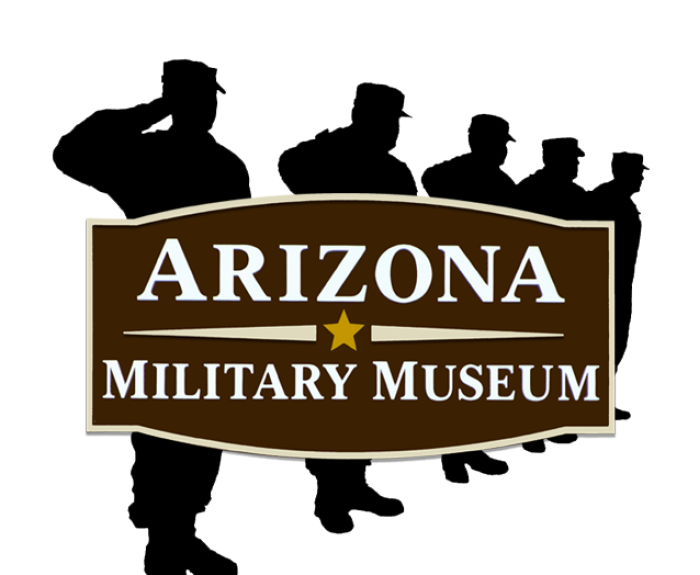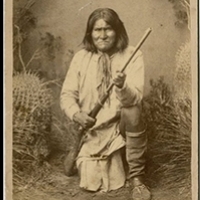Arizona Military Museum

The Museum is indefinitely closed. We apologize for this inconvenience and are hopeful to announce reopening in the near future.
The Historical Society’s purposes are: “To enhance the appreciation of the military history of Arizona and the contributions of the Militia of Arizona and the Arizona National Guard to the State of Arizona and to the Nation…” (Bylaws, Article I, Section 1). To accomplish its purposes, the Historical Society shall strive: “…to discover and memorialize the history of the Military of Arizona, the Arizona National Guard, and the general military history of Arizona, and to establish and maintain a museum on land leased, owned, or otherwise controlled by the Society.” (Id.). The policy statement states that the Historical Society is “…to portray events, persons, and other historical information relating to…the military service of Arizonans in wars and other military actions in Arizona and around the world”.
On September 30, 2006, the Arizona Military Museum celebrated its 25th anniversary. The museum building is a significant part of Arizona's military history. The raw adobe building was constructed in 1936 as a Depression-era public works project. It served as a National Guard arsenal until World War II, when it was converted into a maintenance shop for German prisoners of war confined at a nearby POW camp.

Other than the indigenous inhabitants who populated what is now Arizona in prehistoric times, the Spanish Conquistadors were the first “military” to explore what is now Arizona in the 16th century. In their quest for gold, they mined and subjugated those with whom they came in contact to do their bidding. As the Spanish further populated Latin America and moved north through Mexico to present day Arizona and beyond, they brought their customs, culture, and religion. They built presidios (e.g., Tubac and Tucson) and missions (e.g., Tumacocri and San Xavier) and developed the Southwestern United States. Tucson was a Spanish presidio (fort and settlement) in 1775 before the U.S. Declaration of Independence. In 1821, Mexico won its independence from Spain. In 1848, the U.S. won its war with Mexico, and U.S. troops patrolled from Fort Yuma just across the Colorado River to protect the gold seekers on their way to California in 1849. With the signing of the Gadsden Purchase in 1853, Arizona acquired the land from the Gila River to its present boundary with Mexico.
From the late 1850s to the late 1880s military units were fighting the Indian Wars. During the Civil War the military was fighting in the East, but the Apaches were raiding ranches, Overland Stage stations, and wagon trains. Military posts--Fort Defiance, Fort Whipple, Fort Apache, Fort Verde, Fort McDowell, Fort Lowell, Fort Bowie, etc.--were scattered throughout Arizona. During the Civil War three skirmishes occurred in Arizona between soldiers of the North and South—Picacho Peak, Stanwix Station, and La Paz on the Colorado River. The South was interested in the gold in California, and the North was going to protect it.
With the Civil War still going on and Carleton still fighting the Navajos, the U.S. War Department therefore authorized Governor John Noble Goodwin of Arizona to raise five companies of Arizona Volunteers in 1864. Recruitment was delayed for a year, but by the fall of 1865, more than 350 men had been issued into service under the command of nine officers. The overwhelming majority was Mexicans, many of them from Sonora, or O'odham and Maricopas from the Gila River villages, who had grown up fighting Yavapais and Apaches, as had their fathers and grandfathers.
For the next year, they guarded wagon trains between Prescott and La Paz and campaigned relentlessly across central Arizona. According to the Third Arizona Territorial Legislature, the volunteers inflicted "greater punishment on the Apaches than all other troops in the territory." Traveling "barefoot and upon half rations," they killed 150 to 173 Apaches and Yavapais while losing only ten men in combat themselves. If their enlistments had been extended, as many territorial officials and army officers requested, the centuries-old alliance of Hispanic, O'odham, and Maricopa frontiersmen might have conquered the Apachería for the Anglo newcomers. The Apache problem was finally quelled with the surrender of Geronimo in 1886 at Fort Bowie.
When the Spanish-American War began in 1898, Arizona provided two troops of 250 men to go to San Antonio, Texas. There, the recruits became part of the First Volunteer Cavalry, or as their executive officer, Lt. Colonel Theodore Roosevelt, used to call them--the “Roughriders”.
In 1916, during the Mexican Revolution, Pancho Villa’s men killed 17 Americans in Columbus, New Mexico. President Wilson sent General Black Jack Pershing into Mexico with an expeditionary force to kill or capture Villa. The First Infantry Regiment of the Arizona National Guard was part of General Pershing’s army and was mobilized to assist Pershing’s troops by guarding and patrolling the border between Douglas and Naco, Arizona. The First Arizona Infantry Regiment continued its mission on the border until World War I was declared on April 6, 1917.
The First Infantry Regiment was drafted into federal service in 1917, re-designated as the 158th Infantry Regiment and sent overseas in July and August 1918. In France, the 158th Infantry was assigned to a division, which furnished replacement personnel to other units. The 158th Infantry was honored to act as guard of honor to President Wilson during his residence in France in 1918, and the 158th Infantry Band was chosen as Wilson’s honor band. The regiment was mustered out of federal service on May 3, 1919.
On 16 September 1940, with the declaration of the National Emergency, the 158th Infantry joined its parent organization, the 45th Division at Ft. Sill, Oklahoma. After December 7, 1941 attack on Pearl Harbor, the 158th Infantry Regiment was removed from the 45th Division and became a separate Regiment. In January 1942, the Regiment embarked at the Port of New Orleans and disembarked in the Canal Zone.
In Panama they trained in jungle warfare and become famous for jungle-fighting skills. The Regiment took the name of the Bushmasters after the deadly bushmaster snake, which became the distinguishing shoulder patch of the 158th Regimental Combat Team. The name "Bushmasters" became well known through the National press. General Mac Arthur, himself, personally selected and requested that the Bushmasters be sent to his command in the Southwest Pacific Theater.
The “Bushmasters” were General Douglas Mac Arthur’s point (lead) element in many actions. After being relieved by divisions in various campaigns in which they distinguished themselves across the Pacific, the 158th Infantry was selected to spearhead the final invasion of Japan. The Bushmasters were under orders to proceed two days ahead of America's crushing D-Day to silence Japanese air warning stations south of Kyushu. The timely capitulation of Japan saved the 158th Infantry from what many believed would have been a certain suicide mission. In October 1945, the 158th Infantry landed in Yokohama, Japan, and members were then shipped home as the 158th was deactivated at Utsunomiya, Japan on January 17, 1946 General Mac Arthur gave the Bushmasters the accolade, “No greater fighting combat team has ever deployed for battle”.
The Arizona National Guard retained the 158th Infantry until the unit converted into Military Police and Transportation Corps units effective December 7, 1967. The Headquarters, 153rd Artillery Brigade carried on the lineage and distinctive insignia of the 158th Infantry. Today the 1/158th Infantry assumes the lineage.
Arizona’s military history also involves the numerous Army Air Corps training fields scattered throughout the state without which thousands of pilots would never have been trained to support the war effort. After the war, the Air Force was formed as a separate service, and Major General (Ret.) Barry M. Goldwater was instrumental in the creation and development of the Air National Guard. The Arizona Air National Guard continues to have vital missions with air refueling missions, foreign nations’ fighter training, Weapons Directors’ training, and MQ-1 Predator (UAV) missions.
Both the Army and Air National Guard were involved in the Berlin Crisis. The 161st Fighter Group, Air National Guard and the 222nd Transportation Company of Winslow, Arizona were mobilized and supported this Cold War effort.
Arizonans have answered their nation’s call to arms to support national policy through Korea, Viet Nam, Panama, Grenada, Desert Storm, Afghanistan, and Operation Iraqi Freedom. Members of the Arizona National Guard are deployed to Afghanistan, Iraq, and elsewhere in the service of their country as of this writing.
Inside the Museum Photo Gallery
The Arizona Military Museum Library has an outstanding collection of old and new books, periodicals, historical records, videos and written memorabilia, official military histories, specialized encyclopedias, copies of military orders and maps.
Military exhibits include a large weapons display and an actual UH-1M Army Combat Helicopter (gunship) flown in Vietnam.
The dramatic and colorful military history of Arizona begins with the Spanish Conquistadors and continues to this day. There's something at the Museum for everyone--kids to seniors. Visitors can view over twenty-five authentic displays of everything from uniforms to weapons to armored vehicles, and as a result, gain a better understanding of the contributions made by Arizona veterans who serviced their country.
Student and other organization tours are welcome. Please contact the museum to arrange your visit/tour. The museum is open on Saturdays and Sundays from 1 - 4 p.m. Except
The museum shares the building with the Arizona Regional Training Institute on Papago Military Reservation at 52nd Street and East McDowell Road. The Museum theme is Lest We Forget, to remind visitors of those in uniformed military service who served their country or lost their lives in combat
If your military memories are packed away, taking up storage space, where no one else can appreciate their historical value, consider donating them to the Museum. We are continuously looking for military-related artifacts of any size, shape or description. Not only will we help preserve your artifacts you will receive a tax deduction for your contribution.
Memberships
We also have Museum memberships available to the public. This is a dual membership including the Arizona Military Museum and the Arizona National Guard Historical Society, Inc., the museum's sponsoring agency. The annual membership fee is $25 and includes the museum newsletter. Life memberships of $250 are also available.
Volunteers
The museum can also use volunteers. If you are looking for an opportunity to volunteer your time, while helping to preserve Arizona's Military History, we need volunteers with the following skills: carpenter, electrician, dry wall, painter, artist, photographer, computer operator, typist, historian, orator, and general handyperson. We also need assistance with sweeping, dusting, mopping, organizing, tour guides or any other task for which you'd be willing to volunteer.
For further information regarding artifact donations, museum memberships, or volunteering, phone the museum at (602) 267-2676 | (602) 253-2378.
Arkanass National Guard Museum
California State Military Museum
Illinois State Military Museum
Museum of The Kansas National Guard
Kentucky Military History Museum
Louisiana Maneuvers and Military Museum
Museum of the Maryland National Guard
Massachusetts National Guard Military
Air Force Historical Research Agency
Arizona Library Archives and Public Records
